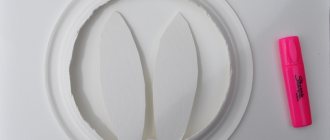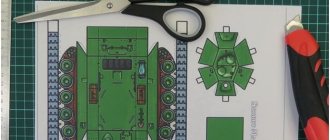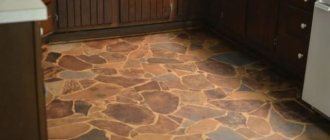Types and features
The rods can be divided into composite and telescopic. Examples of the latter are the Russian Tesla or the Turkish Nokta Makro Anfibio.
Homemade rods can also be non-separable - this design is a priori lighter and stronger. But it’s inconvenient to carry such a barbell.
We also divide according to the method of laying the coil cable - inside or outside. As an example of an internal gasket, let’s take the Nokta Makro Impact. The pipe profile is also different. If all Tesoro metal detectors have a round pipe, then the same Impact has a triangular cross-section.
There are also differences in shape. S-shaped with a handle on a bend (XP Deus), T-shaped (Garret ATX) with a handle almost at a right angle to the bar and hybrid - with an S-shaped bar and a handle made according to a T-pattern, for example the famous “grater” - x-terra 705. Other variations are possible.
How to make a magnetic holder for a laser level with your own hands
The magnetic tripod is made of a metal profile. The sequence of actions is as follows:
- Draw up a drawing and apply markings.
- Saw off part of the workpiece.
- Get a strip from a metal plate.
- Sand it down.
- Bend at a right angle.
- Drill three holes in the workpiece.
- Screw a bolt into each of them.
- Place the ends and nail them with a hammer.
- Screw the corner to the main part.
- Attach the bracket to the tripod and place the instrument.
Bar armrest
It can be removable or non-removable, adjustable or non-adjustable. Of course, when purchasing, you should choose an adjustable armrest, and when manufacturing, opt for a stationary version - it’s lighter, more durable, and easier to manufacture.
Lower rod
Prefabricated or solid, telescopic or composite. Generally speaking, length adjustment is possible only through the lower rod, which is why on production models it is made at least two-part.
When making it for yourself, you don’t have to make any connections - the structure will be lighter and stronger. But a non-adjustable lower rod will then limit the search area - in basements or low attics a short rod is more convenient.
Tip for attaching the coil
In most serial metal detectors, the coil mount is made in the form of a bushing, which is T-shaped attached to the lower rod. The coil ears cover the ends of the bushing, and a fastening bolt is threaded through the holes.
But not the entire series is like this. Tesla went a different route; its coil has one eye, and the bushing on the lower rod is much narrower.
When buying a metal detector, look at the reviews - for example, many detectors note that MD Mars coils do not fit well with the wide bushings of Nokta Makro detectors. Which is fraught with physical destruction of the reel ears.
Metal detector design
Unlike locators, where the principle of echo reflection is used, in metal detectors the emitted and received pulses operate at the same frequencies. The simultaneous reaction of both coils, in this case, occurs only to detected metal objects.
The device, whose operation is based on a well-established principle of transmission and reception, perceives a signal reflected from the objects being sought, which the researcher hears in headphones.
A simple circuit, which contains a power source in the form of a battery or accumulator, transmitting and receiving magnetic coils, a chopper and headphones, is quite effective in practice.
Among the disadvantages of the simplest detectors, researchers note the excessive sensitivity of the devices to the geological features of the soil in which metals are searched.
The base or shaft of the device should be comfortable to wear for long periods of time and made from non-conductive materials such as rubber, plastic hose or wood.
The coil transmitting energy is attached to the bottom of the holder, forming the desired angle of inclination to the ground.
The middle rod can be made of two threaded parts to adjust the height of the device. The upper part consists of an armrest, and the control panel is also mounted on it.
The electronic control unit of the device is needed to process incoming data, and the complexity of its design may vary, depending on the needs of the manufacturer. An insulated wire runs from the bottom coil to the top coil, which is connected using a plug.
All detector elements must be protected from moisture with insulating materials to avoid numerous interferences and short circuits of electrical devices.
What to look for when choosing
If a digger decides to replace the broken rod of his metal detector, he should pay attention to original spare parts, new or even contract ones. You can buy “original” rods for almost all serial products.
If buying or making a new rod is a matter of tuning, then you should go from the tasks: to make the device lighter, or to expand the range of tasks, or, conversely, to narrow it. For example, it’s only worth taking carbon fiber for a beach cop - aluminum doesn’t do well in sea water and corrodes.
But the main thing in a barbell is not the weight, but the balance. If you constantly have to “push” the metal detector away from you, if it hits your elbow, the balance is in the armrest, and this is bad. If, on the contrary, the hand turns forward and the elbow pushes upward, that’s also nothing good.
Balance is an individual thing and it is worth choosing a barbell so that it matches the user’s sensations.
Reviews of models and manufacturers
Users say kind words about the Golden Mask carbon fiber rods - they are light and durable. They even buy these rods and put coils and control units from other metal detectors on them.
XP has taken an interesting step by releasing rods for its Orx device and promoting them as a viable alternative to replacing coils on a single rod. The weight of the all-plastic rod is only 300 grams. The wireless control unit can be easily and quickly transferred from rod to rod, saving time on replacing the coil or the lower rod with the coil.
We recommend watching a video about the Ice 250 (Garrett Ace) metal detector with a universal rod from Mars MD.
The universal rod is more interesting than the standard one.
Another example of replacing a rod is a video from the Ohio Metal Detecting channel about using a fiberglass rod from Anderson Detectors for Minelab Excalibur.
Helpful tips for use
Some useful tips can be found in the video “Excursion with a metal detector” from comrade Alex Treasure Hunter.
We hope that our article has covered all the important aspects of choosing a rod for a metal detector.
Hi all! Today we will talk about metal detectors. Probably, many radio amateurs have assembled search metal detectors, because when you have knowledge in the field of radio electronics, there are no problems with assembling a metal detector, and searching with the device is very exciting! So, if you have ever assembled a metal detector, you have probably encountered the problem of assembling the rod. It seems that you have assembled the electronic unit and you can go digging, but no, without a barbell it will be very inconvenient and you will quickly get tired (tested from personal experience). Of course, you can buy a ready-made barbell and not bother with its assembly and design, but we are not looking for easy ways. Therefore, I decided to assemble it myself.
Read also: How to make a paper rocket: 10 step-by-step diagrams
First of all, you need to decide on the material. The most accessible and cheapest material? plastic plumbing pipes. If you have a heavy reel, then you need to choose a thicker pipe, but if it’s light? You can also take a thin one. The main thing is that the pipe does not bend under the weight of the coil. My coil is heavy, since I filled it with epoxy in a homemade foam mold.
Therefore, I took a pipe with a diameter of 32 mm. A pipe of this diameter is rigid and does not bend, that is, it fits perfectly.
In addition to the pipe, we need 2 45 degree angles and 2 pipe connectors (fittings). The connectors must be threaded and dismountable so that the rod can be dismounted. The connectors look like this:
If you have a soldering iron for plastic pipes at home? you are lucky, if not, then find a plumber, they will solder them for you for a small price. For example, a friend of mine had this soldering iron.
First of all, you need to mark the purchased pipe. I bought 2 meters, although 1.5 m would have been enough. You need to mark everything in relation to your height, since everyone has a different height, therefore, the total length of the bar is different for everyone. I marked by eye. The pipe must be divided into 5 parts. Will the coil be attached to one part? you need to drill a hole in it. The second part of the pipe will be connecting between the first and third (for convenience, so that the disassembled rod does not take up much space). The third part will consist of three parts. The photo shows everything clearly:
Also in the photo the places that need to be soldered are highlighted in yellow.
As you understand, three parts need to be made in order for the bar to be collapsible. The more parts? the less space it will take up when disassembled.
You also need to pay attention to how the coil is attached to the rod. You need to take into account the distance between the ears of the reel; mine was slightly smaller than the diameter of the pipe, so the pipe had to be trimmed from the sides.
I secure the coil with a plastic toilet bolt. It's not very expensive and suits us perfectly.
Also, to attach the electronic unit to the rod, you need to buy a clip corresponding to the diameter of the pipe.
The clip can be screwed to the block, or it can be glued. I screwed it on, but it didn't hold quite tightly, so I secured it with additional electrical tape. It didn't turn out pretty, but it was reliable.
ROD MADE OF PLASTIC PIPES FOR METAL DETECTOR
Hi all! Today we will talk about metal detectors. Probably, many radio amateurs have assembled search metal detectors, because when you have knowledge in the field of radio electronics, there are no problems with assembling a metal detector, and searching with the device is very exciting! So, if you have ever assembled a metal detector, you have probably encountered the problem of assembling the rod. It seems that you have assembled the electronic unit and you can go digging, but no, without a barbell it will be very inconvenient and you will quickly get tired (tested from personal experience). Of course, you can buy a ready-made barbell and not bother with its assembly and design, but we are not looking for easy ways. Therefore, I decided to assemble it myself.
First of all, you need to decide on the material. The most accessible and cheapest material is plastic plumbing pipes. If you have a heavy reel, then you need to choose a thicker pipe, but if it is light, you can take a thin one. The main thing is that the pipe does not bend under the weight of the coil. My coil is heavy, since I filled it with epoxy in a homemade foam mold.
Therefore, I took a pipe with a diameter of 32 mm. A pipe of this diameter is rigid and does not bend, that is, it fits perfectly.
In addition to the pipe, we need 2 45 degree angles and 2 pipe connectors (fittings). The connectors must be threaded and dismountable so that the rod can be dismounted. The connectors look like this:
If you have a soldering iron for plastic pipes at home, you are lucky; if not, then find a plumber, they will solder them for you for a small price. For example, a friend of mine had this soldering iron.
First of all, you need to mark the purchased pipe. I bought 2 meters, although 1.5 m would have been enough. You need to mark everything in relation to your height, since everyone has a different height, therefore, the total length of the bar is different for everyone. I marked by eye. The pipe must be divided into 5 parts. The coil will be attached to one part - you need to drill a hole in it. The second part of the pipe will be connecting between the first and third (for convenience, so that the disassembled rod does not take up much space). The third part will consist of three parts. The photo shows everything clearly:
Also in the photo the places that need to be soldered are highlighted in yellow.
As you understand, three parts need to be made in order for the bar to be collapsible. The more parts there are, the less space it will take up when disassembled.
You also need to pay attention to how the coil is attached to the rod. You need to take into account the distance between the ears of the reel; mine was slightly smaller than the diameter of the pipe, so the pipe had to be trimmed from the sides.
I secure the coil with a plastic toilet bolt. It's not very expensive and suits us perfectly.
Also, to attach the electronic unit to the rod, you need to buy a clip corresponding to the diameter of the pipe.
The clip can be screwed to the block, or it can be glued. I screwed it on, but it didn't hold quite tightly, so I secured it with additional electrical tape. It didn't turn out pretty, but it was reliable.
Pipe connectors
Now I’ll tell you about connectors and how to use them. If you take it apart, you will see the following picture:
These white plastic rings need to be put on the end of the pipe where the connector will be. And do everything as shown in the figure:
Actually, that’s all, the main thing is to choose the right size for yourself. Here's what we ended up with:
I haven’t made a compartment for the battery yet; I carry the battery in my bag.
Also, you will also need to make an armrest. It's very easy to do. You need to take a large diameter plastic pipe and cut it in half. Good luck to everyone, friends. Kirill was with you.
Forum for discussing the material ROD FROM PLASTIC PIPE FOR METAL DETECTOR
Homemade 9 V lithium polymer battery, assembled to fit a standard Krona-type case.
Theory of operation of switching power supplies and circuit design options.
A preamplifier with a stereo tone block for a power amplifier, assembled using an op-amp 4558.
Pipe connectors
Now I’ll tell you about connectors and how to use them. If you take it apart, you will see the following picture:
These white plastic rings need to be put on the end of the pipe where the connector will be. And do everything as shown in the figure:
Actually, that’s all, the main thing is to choose the right size for yourself. Here's what we ended up with:
I haven’t made a compartment for the battery yet; I carry the battery in my bag.
Also, you will also need to make an armrest. It's very easy to do. You need to take a large diameter plastic pipe and cut it in half. Good luck to everyone, friends. Kirill was with you.
Forum for discussing the material ROD FROM PLASTIC PIPE FOR METAL DETECTOR
Homemade 8-channel PWM MOSFET LED Chaser on a 16F628A microcontroller.
Schematic diagram of galvanic isolation for an 8-channel logic analyzer. Data transfer speed up to 10 Mbit.
What do the terms switch, toggle switch and button mean - what are the main differences and features of the use of each of them.
So, after successfully making a mono search coil, the next task arose: how to make a homemade rod for a metal detector from shit and fiberglass sticks and epoxy glue.
Why from these materials? Well, first of all, I was impressed by how some craftsmen made an incredibly cool rod for a metal detector with their own hands (one and two times), and naturally I immediately wanted to make the same one. Secondly, you can use epoxy glue to create anything you want, even the devil of a bald person. Thirdly, epoxy is easy to obtain, it is easy to process, and, if necessary, it can be easily repaired by gluing the fallen pieces.
In general, I studied various options for making rods for metal detectors - from plastic pipes, a crutch, a fishing rod, and even from wooden sticks. At first, I bought into the ease of making a rod from polypropylene pipes and even bent one of them and welded the tip (the role of which was played by a tee). (I welded it, by the way, by heating it using ordinary household gas in the kitchen.)
But despite my unpretentious taste, this design looked too collective farm-like. And, besides, it turned out that PP pipes do not have sufficient rigidity and when you start swinging such a “barbell” from side to side, it bends like snot.
Maybe this is not critical for the search, but it is purely psychologically uncomfortable. It seems that the reel has a life of its own, as if you were trying to move a brick tied to a long rope from side to side.
As a demonstration, I filmed a short video, so you can evaluate the deformation of the last leg of a polypropylene rod and compare it with a fiberglass rod. The conditions for both pipes are absolutely the same: the length is the same (60 cm), the coil itself is the same (its weight is about 300 g).
So the question of what a rod for a metal detector can be made from was clearly resolved in favor of fiberglass.
Intuition suggests that the bar will experience the greatest bending force in the horizontal direction while swinging the coil back and forth (due to its inertia). And the vertical component of the force acting on the rod, firstly, is not very large and is equal to the weight of the coil, and secondly, it is static. Therefore, it makes more sense to make the pipes for the rod not round (or square), but rectangular.
By choosing a rectangular rod profile, we obtain sufficient rigidity in each direction (vertical and horizontal), but at the same time save material, and therefore the weight of the rod.
Read also: Garden planter in the form of a stump
In addition, the rectangular shape of the pipes will make it impossible for them to rotate relative to each other, which means that the search coil will not be inclined to become askew (when, for example, it gets caught on a cobblestone). And in general, the whole structure will look much cooler and more technologically advanced! Purely visually, the barbell will not look too bulky.
Having looked at various factory-made and home-made metal detectors on the internet, it was decided to put together the Deus XP idea as the most convenient and attractive.
It’s not for nothing that everyone who made homemade rods for metal detectors from fiberglass and epoxy, as one, repeated exactly the Deus idea. Here is one of them:
And here is the second rod made of pipes made by hand, found in the vastness of Tyrnet:
Thus, the entire structure should consist of three parts - two knees that telescopically fit into each other, and a third part with a handle and an armrest, on which the unit with electronics and batteries will be attached.
First you need to decide on the size of the metal detector rod with your own hands (the drawing will be shown below).
- the distance from the sensor mounting axis to its nearest edge is 67 mm (this is to determine the location of the eccentric on the rod. I want the clamp to not interfere with the coil under any circumstances),
- the height of the sensor mounting axis relative to the ground plane when performing a search is 50-60 mm (this is for calculating the length of the rod),
- one elbow of the rod should be pushed into the other by at least 15 cm (this is to reduce their mutual play to a minimum and at the same time ensure sufficient strength of this joint),
- my height is 180 cm (this is the most important thing for calculating the length of the metal detector rod).
If you look at the photos of dudes and dudes with metal detectors, you can see that in real conditions the rod is located at an angle of 50 to 60 degrees to the horizon. The last picture doesn't count, because... There is generally a straight design, plus, moreover, a hefty coil, which is why it has to be carried away from the feet.
Therefore, when making calculations, the minimum angle of the bar relative to the ground (that is, when it is extended to its maximum length) should be taken as 50 degrees .
Having all the necessary initial data, we get the following picture:
The picture seems slightly disproportionate, but this is due to the fact that this man is hunched over and his head is bowed. If he straightens up, everything will fall into place.
Taking into account all of the above, this is the drawing of the metal detector rod:
If the dimensions are hard to see, then here is a larger picture - tsmyk.
Well, let's start making it. I think the pipes for the rod themselves should be made with a margin of 1-2 cm, so that there is room to roam when processing the edges. And it's never too late to prune.
By the way, if your height differs from that given in the calculations, you can adjust the maximum length of the barbell. In order not to bother with the calculator for a long time, you can follow the following rule: for every 5 cm of growth, the length of both (.) knees should be changed by 2 cm.
And if we calculate all the parameters for a obviously larger height (for example, 190cm), then we will get a universal rod for a metal detector, which, thanks to its telescopic design, is guaranteed to suit any digger.
Unfortunately, I could not find a sufficient amount of fiberglass anywhere, so I will make almost the entire rod for the MD with my own hands from fiberglass.
And only the most important things - eccentric clamps, armrest, etc. - I will make it from fiberglass.
The fact is that fiberglass is much worse than fiberglass. It breaks easily at bends, breaks even with a slight tension, requires more resin for full impregnation and is generally unreliable.
How to make a tall tripod for a laser level from propylene pipes with your own hands
From leftover polypropylene pipes you can make a microlift for a laser level with your own hands. The step-by-step instructions are as follows:
- First, blanks are made from nine scraps of polypropylene pipes. This quantity is enough to construct three legs. If the length of each fragment is 60 cm, you can use them to make a spacer stand for a laser level with a height of 50-100 cm with your own hands.
- Take six pieces out of nine and place them on one part of the coupling. You need to work using a welding iron. After this, 3 trims are laid in one row (in the center there is a regular polypropylene pipe without a coupling).
- The next stage of making a stand for a laser level with your own hands is to place a piece of plywood or MDF panel on top and secure it with clamps. Next you need to drill holes and make threads. Screw the workpiece using screws. Assemble the remaining two legs with your own hands in the same way.
- A long self-tapping screw must be inserted into the middle polypropylene pipe of each leg. You can use it to install a homemade tripod if the surface is uneven. Then you need to fix the legs together using three corners.
Important! Using the technology described, you can make a tripod for a laser level with your own hands. This is a convenient device that does not take up much space. It can be used as a tripod not only for a level, but also for a camera, level and other tools.
Bottom bend of the bar
We go to the nearest Leroy Merlin and for 100 rubles we buy an aluminum pipe with a rectangular section of 10*20 mm. We coat it with any consistency (solid oil or something similar), wrap it with cling film and the blank is ready.
Next, you need to figure out what size you need to cut the fiberglass canvas. For the lower bend of the metal detector rod, it is enough to make the walls 2 mm thick. It was experimentally established that the thickness of one sheet of fiberglass is 0.15 mm.
Simple mathematical calculations show that you need to take a sheet 88 cm long. Well, the width of the sheet is equal to the length of our future knee, i.e. 62 cm.
We cut off the required sheet and roll it onto our blank, evenly coating it with epoxy glue.
To find out in advance how much glue you will need, you need to calculate the volume that it will need to fill:
V = (2.2cm * 1.2cm - 2.0cm * 1.0cm) * 62cm = 39.68 ml
If you also have fiberglass, then I sympathize with you; prepare resins for the entire calculated volume. And if you have normal fiberglass, then you can use 30 percent less glue.
By the way, it is better to prepare epoxy with some reserve (10%) - it’s better to squeeze out the excess resin than not have enough of it.
Despite the fact that after making the rod I will paint it black, I also decided to tint the glue a little. So that the material from which the rod is made is painted throughout its entire thickness. To do this, I used the first thing that caught my eye - black enamel PF-115.
In general, I do not recommend painting epoxy resin this way. Firstly, it stinks for a long time, and after hardening, the surface of the product becomes slightly oily. If you later need to glue/glue something, the resin will no longer stick so well. Therefore, it is better to use some kind of pigment dye, for example, the same aniline black (with which rags are dyed in the textile industry).
When you wind the fiberglass cloth (fiberglass) onto the mandrel, you will definitely feel that there is not enough glue. Now, don't believe it, it's an illusion. In fact, when you compress the wound fiberglass fabric to the calculated wall thickness, the resin will fill the entire volume allocated for it and saturate the entire fiberglass fabric completely, displacing the air. Simple arithmetic!
Read also: Making a hand drill for poles with your own hands
A jamb can only happen if you don’t press the walls to the required thickness, then there really may not be enough glue (that’s why I recommended preparing the resin with some reserve). By the way, this happened to me once. I was greedy with glue and in the end it was not able to saturate the entire fiberglass, leaving white bald spots:
The material in these places is easily pressed and crunches like a wafer.
In order for the outer edges of our future pipe to be even and smooth, we need to cover it on top with even planks and press it properly. The boards must first be covered with tape, otherwise they will stick tightly. I think the most suitable material for these purposes is chipboard (shelves and doors from old cabinets that are constantly lying around everywhere).
For myself, I built a monstrous structure from boards and studs with wings.
By the way, in the previous photo you can see that the fiberglass is not impregnated with resin at all. And there seems to be very little glue. But, as I said above, this is not the case. Once we tighten the nuts properly, everything will be fine. Even excess resin will appear.
We wait for the resin to harden and remove the resulting workpiece into the light of day. We remove flash and excess sagging.
Purpose and features of the metal detector
The first attempts to create a detector for detecting metals in various environments were made at the beginning of the 20th century. At first, with its help, factory owners monitored the leakage of parts from production. But subsequently various types of the device appeared, which benefited military and industrial specialists. Too large dimensions made it difficult to widely use the devices, but in the 60s, lightweight models with a simpler structure began to appear, the principles of which have been preserved to this day.
The action of the detector device is based on the force of attraction of metals by 2 magnetic coils, the first of which creates a magnetic pulse, directing it into the soil. The other plays the role of a receiver of the reflected signal from objects located at depth with strong conductivity of electric current, which include almost all metals.
To prevent the emitted magnetic radiation from directly hitting the receiving element of the device, an inductive equilibrium is created in which the system is balanced in such a way that the output signal is 0. Provided that a metal object enters such a balanced circuit, an imbalance occurs, as indicated by the incoming signal .
When the objects you are looking for are in the area affected by the magnetic pulse, a corresponding signal is generated, which is transmitted through the headphones.
Its strength may vary depending on the range or depth of metal fragments.
The sensitivity of a metal detector directly depends on the size of the first coil that creates the magnetic field - increasing its size expands the capabilities of the devices.
Using a simple electronic device, you can find valuable objects and scrap metal that are inaccessible to normal perception in a neutral environment, as well as in moist soil with low conductivity. A metal detector gives a signal about the presence of iron, silver, copper or similar materials in various soils, water, old walls, among various things in a dump and in living organisms.
Middle knee
As a mandrel for the second segment of our barbell, we will use the lower elbow we just made.
The required length is 61 cm, wall thickness is 2.5-3 mm.
We prepare approximately 130 ml of epoxy glue, cut a fiberglass cloth measuring 145x61 cm, and wrap it around our mandrel.
In order for the pipes to be separated after hardening, we coat our mandrel with grease and put a couple of turns of cling film on top. In a word, we repeat everything that we did when making the lowest bend of the bar, except that now the mandrel is not a metal profile, but a ready-made lower bend.
In general, we wrap the blank with fiberglass, coat it with epoxy, and lay it on top with even boards, previously covered with tape. Then we tie everything together with either adhesive tape or blue tape. Well, in my case, I again used the same superb mold with lambs:
If anyone is interested, the first attempt to make the second bend of the barbell was a fiasco. Despite the layer of polyethylene and lubricant, the two pipes adhered to each other so firmly that there was no way to separate them. I had to rip open the entire length of the top tube and start over.
The second time I decided to try the rope-solidole method:
According to my idea, after hardening, I will pull the rope turn by turn and remove the inner pipe without any effort. But, as often happens, fate had other plans for this.
When everything froze, I began to slowly wind the thread turn by turn. And after about 5-10 cm, the rope jammed tightly there and it broke. I tried to do the same trick on the other side, but I failed there too. So never use linen rope for these purposes, use nylon rope.
In short, I disconnected the pipes for a long time and tediously, with the help of studs, nuts, all sorts of devices and brute physical force. It took me half a day to do this, but I still achieved my goal. Now I have two pipes that fit freely into each other.
How to make a telescopic rod for a laser level with your own hands
The telescopic design rises to any height, making it convenient to work in different rooms. To make it yourself, proceed as follows:
- Glue the threaded sleeve with two-component glue.
- Raise the instrument as high as possible, resting it on the ceiling.
- Tighten the nut from below to select the optimal height.
- Markings are applied on a small piece of plywood.
- Cut out the part (bracket) according to the marks with your own hands.
- Using a metal clamp, it is necessary to fix the wooden bracket at the required height.
- Adjust by turning in the desired direction.
Tip for attaching the coil
I made the fastening of the metal detector coil to the rod from the same fiberglass. First I rolled a sausage, then a stick. Then I connected them together. Now a little more detail and with pictures.
The circle wound around the first thing that came to hand - a screwdriver.
After hardening, I cut it to the required length.
It is important for us that the ends are parallel to each other and at the same time perpendicular to the axis. Therefore, I trimmed it using a simple device with sandpaper.
A parallelepiped made of fiberglass is made even simpler - a sausage is wound, flattened to the required thickness and kept in this form until completely cured.
Then it is cut to the required size.
Then we make a rectangular hole in the round, glue the resulting parts together and get the coolest fastening of the metal detector sensor to the rod.
Round diameter - 26 mm, length - 33 mm. The dimensions of the rectangular part are 10x20x50mm, it should fit tightly inside the lower bend of the bar. Then it seemed to me that the length of the pin was too long, and I shortened it by about a third. The total weight of the entire tip is about 23 grams.
By the way, as practice has shown, fiberglass pipes made from fiberglass are very vulnerable at the ends: if you apply pressure from the inside, they easily burst at the corners. Therefore, I decided to strengthen the very tip by gluing a pre-made rim on it.
Here's what it looks like assembled:
To create a high-tech (read: cool!) appearance, the parts adjacent to each other were sawed down at a bevel.
Subsequently, exactly the same reinforcing belt was made for the second pipe:
The next task will be to manufacture an S-shaped handle with an armrest, as well as eccentric clamps for fixing the knees in a given position and mounting for the electronics unit. Read all about this in the second part of the article.
Popular posts
- How to make a freezer out of an old refrigeration device How to make a fireman out of plasticine How to make an endoscope with your own hands How to make a decorative fence on your personal plot with your own hands How to make a summer shower in your dacha with your own hands - drawings, dimensions, materials, step-by-step assembly instructions (81 photos) How to create a rack wood splitter with your own hands, drawing and instructions How to make a wooden rack with your own hands - a detailed master class for beginners How to make a necklace with your own hands - step-by-step master classes for beginners
DIY metal detector at home
Many amateur craftsmen share their experience in creating metal detectors with their own hands on the Internet and in technical magazines.
Among the examples, you can find many interesting technical solutions, from the simplest, assembled on the basis of a mobile phone, to complex ones, operating at a depth of 4 meters and discriminating between metals.
Easy way
If someone who likes to assemble devices with their own hands is far from working with a soldering iron, then it is better to find ready-made boards. You can solve the problem by taking a small receiver and a calculator. To attach them to a dense base, a piece of cardboard folded in the shape of a book cover is suitable, to which they are attached from the inside using tape.
The radio must be tuned to the AM frequency, selecting a free wave.
If you turn on the calculator at the same time, the radio speaker will make a static sound. It can be reduced by bringing two devices closer together, fixing them at the lowest noise level. Such a device will begin to produce stronger sounds at the location of metal objects.
The hard way
The manufacture of a more complex device will require more skills of a radio technician. At the heart of the device there must be a board with several electronic parts that must be soldered according to a certain pattern.
Among them is an electric current generator, to which the first coil is connected. Then a second reference-type generator powers the sensing magnetic coil and operates at the same frequency as the first. From both generators, the signal must be sent to the IC1.2 mixer and then transmitted to the filter and headphone amplifier.
With metal discrimination
Some complex ground detectors are created using induction technology, which allows them to have such a function as a discriminator of different metals.
With its help, you can approximately assess the quality of the metal, immediately eliminating unnecessary types of finds, at a depth of 0.2 to 1.0 meters.










